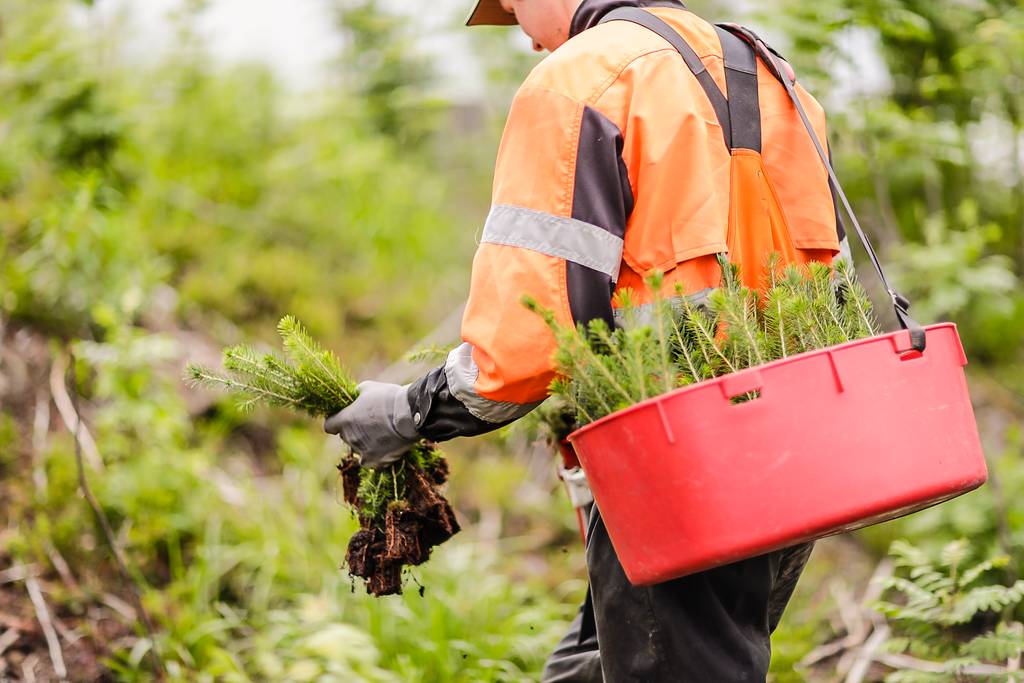Wood is a renewable resource
Of all the major construction materials, wood is the only renewable material. It’s ‘Made in Nature’ from water and CO2 using the energy of the sun. Globally, the construction sector is responsible for about 50% of raw material extraction (GBC, 2022). The use of wood from sustainably managed forests can substitute non-renewable resources and reduce our dependence on energy intensive materials.
Promote sustainable forestry
Building with wood provides incentives for sustainable forest management. Sustainable forests are permanently forested areas that are managed to balance the environmental, economic and social needs of present and future generations. Sustainable forestry is a desirable land-use form, which plays a significant role in securing biodiversity, providing green jobs in rural areas, and offering recreational opportunities. By building with wood, we provide incentives for maintaining our forested areas and securing their sustainable management for the benefit of current and future generations.
Increase our forest area
Using wood ensures the growth of forests. Forests play an essential role in decreasing the greenhouse gasses in the atmosphere, being among the most efficient carbon storing systems on the planet. Building with wood creates a demand for wood which, in turn, creates demand for forest. When we build with wood, we ensure that forests have economic value, which is the best way of protecting our forests from being turned into other types of land-use and provide incentives to increase our forest area. The European forest area has increased by more than 17 million hectares over the past 25 years.
Promote a circular economy
The construction sector uses about 50% of all extracted resources. To ensure sustainable growth and keep our resource consumption within sustainable limits, we must transition from a linear economy based on non-renewable resources to a circular economy based on renewable resources. Wood is the perfect circular construction material. It is made from water and CO2 and at the end of life it is converted back to being water and CO2 through either energy recovery (providing CO2 neutral energy in the process) or biological degradation.
Reduce waste
Wood is produced by trees through the process of photosynthesis. In this process, wood is created from water and CO2 with oxygen (O2) as a beneficial by-product. When a tree is harvested and processed to obtain construction wood, it does not leave waste behind. Branches and roots are left in the forest and degraded by natural processes. The main part of the wood is used for a mix of timber products, while residues like bark and sawdust can be used to generate CO2 neutral energy to operate the sawmill itself or the surrounding community. Nothing from the tree becomes waste.
Timber is durable
We need our buildings and materials to last longer, to reduce the need for new construction and materials. Wood is a natural material that will be degraded by natural processes if exposed to rainwater (i.e. used in exterior applications). However, when used as an interior construction material, it is a robust and very durable construction material that will last for centuries. Wood buildings will have a long lifespan if designed and built properly.
Wood can be reused over and over again
Wood is well suited for re-use and recycling. Wood construction is not welded or cast but assembled using connection systems that can be disassembled. Modern wood construction designs based on design-for-disassembly principles allow for whole building elements to be disassembled and reused at the end of life. If direct reuse of elements is not possible, wood construction materials can be recycled in a cascading approach e.g. to solid wood components, particle boards, wood fiber insulation, etc.
Use our buildings and cities for carbon storage
Wood removes CO2 from the atmosphere and wood buildings are carbon storage facilities. Photosynthesis was invented more than 300 million years ago and is easily still the most efficient carbon capture technology available. Wood is made from CO2 and water, but only the ‘C’ of ‘CO2’ is stored in the wood. This means that wood removes more than its own weight of CO2 from the atmosphere during its creation. In fact, 1 ton of wood has removed approximately 1.8 tons of CO2 from the atmosphere. When we build with wood we essentially use our buildings and cities as carbon storage units.
Wood is a low hanging environmental fruit
The construction sector has a massive environmental footprint. A large part of global CO2 emissions can be attributed to the production of energy intensive construction materials. Using wood in construction is one of the most efficient ways of reducing the construction sectors environmental footprint. Using wood in construction is a technologically mature solution, which provides immediate CO2 reductions and is therefore a low-hanging fruit in terms of reducing the CO2 emissions of the construction sector.


